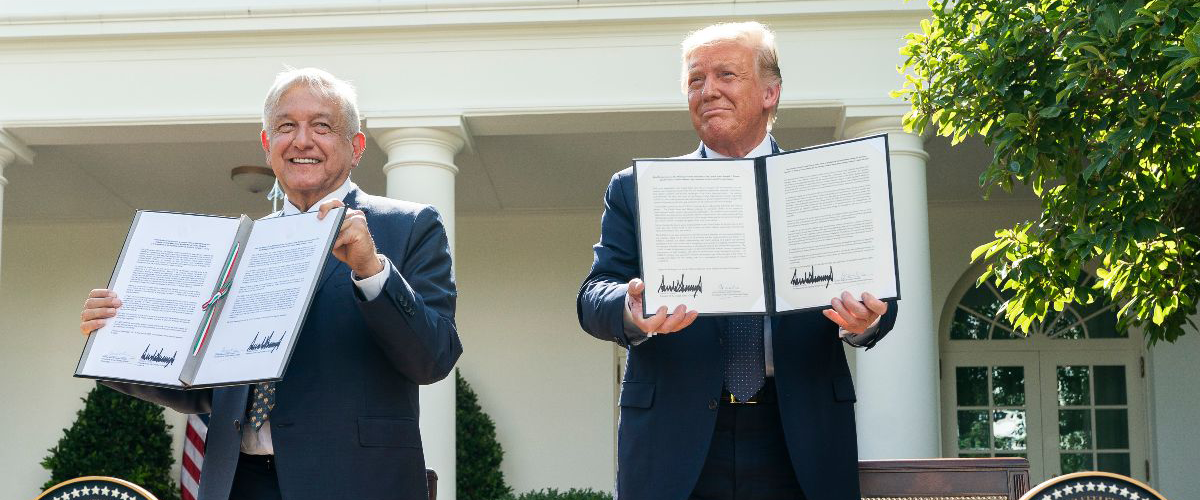As business and industry trumpet the start of North America’s new trade agreement this month, the road ahead is lined with both possibilities and challenges, experts on multinational trade said.
All three countries now must put in the hard work required to advance the largest tariff-free trading bloc on the globe, they said.

“North America’s new regional trade agreement has the potential to propel each of the three member countries individually, and the region collectively, to the highest levels of international competitiveness,” said Duncan Wood, an internationally known specialist on North American politics and the director of the Wilson Center’s Mexico Institute in Washington D.C.
“Now what we have to consider is how each of the three governments is going to do its job making sure we have the right regulations in place, the right legislation in place, and that we can work with business to take full advantage of this.”
Big unknowns
COVID-19 will be one of the biggest concerns on the trek forward, said Marco López, Jr., president and CEO of International Business Solutions, Inc. (IBS), a business advisory firm that provides business development and policy direction to international and domestic organizations.
“We must start thinking and working towards a risk mitigation plan should the economy struggle to meet the new reality post-COVID19,” Lopez said. “We have to now think about the millions of American jobs that the country is losing due to the pandemic.”
Reasons to celebrate
For now, there are many reasons to celebrate, trade experts and business advocates agree.
Most importantly, the new deal allows for the continued tariff-free trade to continue between America, Mexico and Canada, they said.
The new agreement, the United States-Mexico-Canada Agreement (USMCA), is a reboot of NAFTA — the “grandmother of free trade” — that went into effect in 1994 and has helped create the largest free trade bloc in the world.
Globe’s largest tariff-free trading bloc
Since NAFTA’s inception, annual American trade with the two countries has nearly quadrupled to $1.3 trillion, and they purchase more than one-third of U.S. merchandise exports, according to statistics compiled by the U.S. Chamber of Commerce.
Today, trade with Canada and Mexico support nearly 14 million American jobs, and nearly 5 million of these jobs are supported by the increase in trade generated by free trade.
A win for Arizona industry
A 2019 report by the Arizona Chamber of Commerce & Industry, the Arizona Chamber Foundation and the Arizona-Mexico Commission, found that between 2015-2017 Arizona exported $10.5 billion annually to Canada and Mexico. More than 228,000 jobs in Arizona are dependent on the annual trade and investment relationship.
Arizona is now well positioned to continue to attract new manufacturing and supply chains, Wood said.
The introduction of digital and e-commerce into the trade agreement should strengthen Arizona and North America’s competitive edge in global markets with a new emphasis on digital trade and ecommerce, fewer barriers to trade, joint production and the strengthening of existing supply chains, experts said.
Among the benefits cited:
-Raises the “de minimis” customs thresholds under which U.S. businesses may export to Canada and Mexico with reduced paperwork and without paying taxes or duties
-Reduces red tape at the border, reduces costs, and increases predictability for cross-border transactions
-Gives preferential market access for U.S. agricultural exporters, and commitments to fair and science-based trade rules
-Opens up new market opportunities for U.S. dairy and fruit farmers in Canadian markets
-Introduces agricultural biotechnology into the agreement including support for innovation including new technologies such as gene editing
-Introduces a chapter for the first time to support expanded trade for small- and medium-size businesses
Biggest challenges ahead
Covid-19’s impact is one of the biggest challenges facing the region. With millions of people out of work, there will need to be investment by both public and private sectors to retrain them for 21st century jobs, Wood said.
“We need to think about the skills the workforce doesn’t have or skills the people don’t want to learn,” he said.
Missed opportunity for Mexico
Mexico is the least poised to benefit from the USMCA, Wood and other multinational trade experts said.
President Andrés Manuel López Obrador, popularly known as AMLO, has done little to instill confidence in investors, they said. A number of his economic policies and weak relationship with the business community have been widely criticized.
UMCA could be a missed opportunity for Mexico to attract manufacturing and supply chains, Wood said.
“Mexico really is in such a privileged position right now and it needs to open up to the world, it needs to provide legal certainty,” he said. “It needs to provide a regulatory and legal framework whereby investors feel they are protected.”
Positive signs with leaders meeting
A meeting between Trump and AMLO at the White House last week offered signs of a friendlier relationship. But it revealed little about Mexico’s ability to meet the demands of the new USMCA like boosting the hourly wage of auto workers and enforcing environmental standards.
It was AMLO’s first trip during his presidency to a foreign country. In a joint public appearance to herald the USMCA. Trump said he was “honored” to have AMLO as his guest. AMLO called the meeting, the “beginning of a new stage.”
Need for countries to work together to compete globally
While the USMCA is now in place for 16 years, it contains a new clause that allows for review every six years.
That offers an opportunity for dialogue, collaboration and action to incorporate changes, Wood said.
The Wilson Center is launching a series of monthly dialogues with public and private stakeholders from all three countries to identify problems so they can emerge better prepared when the USMCA comes up for review every six years, he said.
“Now, what we have to consider is how each of the three governments are going to do their job making sure we have the right legislation in place, the right regulations in place and that we can work with businesses to take full advantage of this.”
















Add comment